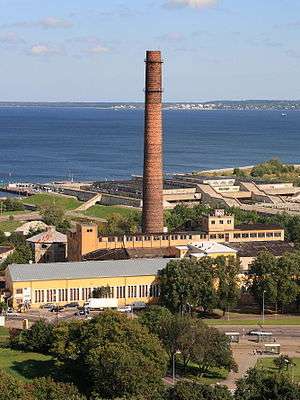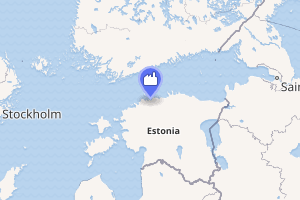Tallinn Power Plant
The Tallinn Power Plant (Estonian: Tallinna elektrijaam) is a former power plant located in Tallinn, Estonia. Construction of the power plant was initiated by Volta company and it was decided by the Tallinn City Council in 1912 after the work of special committee established in 1909.[1] The plant was located next to the Tallinn Gas Factory at the location of the former Stuart fortress.[2] The plant was designed by Volta and the architect was Hans Schmidt.[1][2] Originally it used three Laval-type 250 horsepower (0.19 MW) steam turbines and three 250 horsepower (0.19 MW) electric generators—all produced by Volta. Two coal-fired boilers were manufactured by AS Franz Krull. The power plant was opened on 24 March 1913 and originally it was fired by coal.[1] In 1919–1920 the plant was expanded and transferred to peat and wood.[1][3] In 1924 the power plant was switched to oil shale.[1][4][5][6] It was the first power plant in the world to employ oil shale as its primary fuel.[7][8] In 1939, the plant achieved capacity of 22 MW.[6][9]
| Tallinn Power Plant | |
|---|---|
 Boiler house and chimney of the former Tallinn Power Plant | |

| |
| Official name | Tallinna Elektrijaam |
| Country | Estonia |
| Location | Tallinn |
| Coordinates | 59°26′40″N 24°45′2″E |
| Status | Decommissioned |
| Construction began | 1912 |
| Commission date | 24 March 1913 |
| Decommission date | 2 February 1979 |
| Thermal power station | |
| Primary fuel | Coal |
| Secondary fuel | Oil shale |
| Tertiary fuel | Peat |
| Cogeneration? | Yes |
| External links | |
| Commons | Related media on Commons |
| Wikimedia Commons has media related to Tallinn power plant. |
In 1929, a new turbine hall and in 1932 a new switchboard were commissioned.[3] In 1941, the power plant was destroyed by leaving Soviet troops but was restored by 1948. A new 102.5-metre (336 ft) flue-gas stack was built.[2] On 9 October 1959, the plant started to operate as combined heat and power plant providing district heating to Tallinn.[10] In 1965, the plant was switched to fuel oil.[3] The plant ceased electricity production on 2 February 1979.[10]
In 1978, the power plant area was used for the Andrei Tarkovsky's film Stalker as the threshold to the Zone. The UN's acronym, which is still visible, was painted on the power plant's flue-gas stack.[11] A memorial plate of the film was set up on the flue-gas stack in 2008.
Since 1984, the former power plant boiler house is used as an energy museum. Since 2011, the power plant complex is used for hosting the Tallinn Creative Hub (Kultuurikatel).[12]
Gallery

 Inside view of the boilerroom.
Inside view of the boilerroom. Estacade
Estacade
See also
References
- Nerman, Robert (2004-03-23). "Tallinna esimene elektrijaam saab 24. märtsil 91-aastaseks" [Tallinn's first power plant becomes 91 years old on 24 March]. Eesti Päevaleht (in Estonian). Retrieved 2012-11-04.
- "Kalamaja". Tallinn City (in Estonian). Retrieved 2012-11-04.
- "Tallinna elektrijaama korsten" [Chimney of the Tallinn Power Plant]. National Heritage Board (in Estonian). Retrieved 2012-11-04.
- Ots, Arvo (2007-02-12). "Estonian oil shale properties and utilization in power plants" (PDF). Energetika. Lithuanian Academy of Sciences Publishers. 53 (2): 8–18. Retrieved 2012-11-04.
- Holmberg, Rurik (2008). Survival of the Unfit. Path Dependence and the Estonian Oil Shale Industry (PDF). Linköping Studies in Arts and Science. 427. Linköping University. p. 89. Retrieved 2012-11-04.
- "Direct Combustion of Oil Shale" (PDF). Pace Synthetic Fuels report. The Pace Company Consultants & Engineers. 19 (1): 2–2. March 1982. Retrieved 2012-11-04.
- Ots, Arvo (2006) [2004]. Tyson, Toni; McQuillen, Mary (eds.). Oil Shale Fuel Combustion. Tallinn: Arv Ots; Eesti Energia. pp. 13–17. ISBN 978-9949-13-710-7.
- Aarna, Indrek (2010-09-14). Developments in Production of Synthetic Fuels out of Estonian Oil Shale (PDF). World Energy Congress. Montreal: World Energy Council. Archived from the original (PDF) on 2011-11-25. Retrieved 2012-11-10.
- "Energeetika ajalugu" [History of energy] (PDF) (in Estonian). Eesti Energia. Retrieved 2012-11-04.
- "Tallinna kaugkütte ajalugu" [History of the Tallinn's district heating] (in Estonian). Tallinna Küte. Retrieved 2012-11-04.
- Gamble, Patrick (2019-05-07). "Stalker: in search of Tarkovsky's Soviet sci-fi locations". British Film Institute. Retrieved 2020-01-15.
- "Tallinn Creative Hub". Tallinn Creative Hub. Archived from the original on 2012-09-13. Retrieved 2012-11-04.